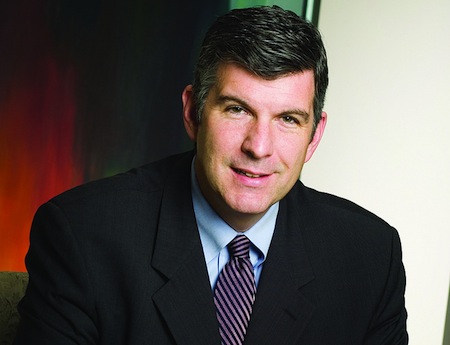CTIA's Carpenter: We Need More Spectrum

Jot Carpenter, VP, government affairs, CTIA: The Wireless Association, told C-SPAN this week that the AWS-3 and broadcast incentive auctions will be helpful, but probably not sufficient to meet burgeoning demand for wireless spectrum. He said auctions and new tech will help, but it's time to start looking beyond those auctions to the next source of spectrum.
He also told Comcast to bring it on if they want to launch a Wi-Fi based wireless service in competition to his members. He also said he understood broadcaster concerns about the auctions, but suggested, as has the FCC, that for some sharing spectrum could be attractive.
Carpenter was being interviewed for C-SPAN's Communicators series, which this week airs on May 5 due to live coverage of the White House Correspondents' Association.
He called those auctions a "very nice down payment," but added that they "probably don't get us all the way to where we need to be."
The FCC's National Broadband Plan back in 2010 set a goal of 300 MHz of mobile over five years and 500 MHz over ten years.
The AWS-3 auction will offer up 65 MHz, while the broadcast incentive auction total has yet to be determined. The FCC targeted 120, but has suggested it could be as low as 45 MHz.
Conceding it was optimistic, Carpenter suggested in the 84 MHz range for the broadcast auction, plus the 65 MHz and the FCC was halfway to that 300 MHz goal for licensed mobile, (actually a little more if the earlier H Block is added in).
Broadcasting & Cable Newsletter
The smarter way to stay on top of broadcasting and cable industry. Sign up below
Carpenter said the next priority is to figure out what is coming in the next tranche of spectrum toward the end of the decade. He said the work to identify that spectrum should start "now."
And where is that next spectrum going to come from? Carpenter said it was tough since there was no virgin swath that the FCC or National Telecommunications & Information Administration can say "go park there."
He said it would likely be from a combination of repurposing more commercial spectrum and federal spectrum as well. He cited making federal spectrum users more efficient and reclaiming some of their spectrum.
In terms of commercial, he suggested "smoothing" the secondary market approval process for his members and others.
The White House has urged more sharing of government spectrum, but Carpenter said he did not want that conversation to "crowd out" one about clearing. He said the answer is both, but suggested the prime directive should be clearing. He said clearing, paired, internationally harmonized, spectrum is the "gold standard" and should always be the goal.
Carpenter also raised a red flag on "cognitive" sharing, saying maybe it was possible in a few years, but that there was no commercially scalable way to do it now.
Carpenter was asked about National Association of Broadcasters president Gordon Smith's concerns that the incentive auction could harm broadcasters and his comment that it was an open question as to whether the FCC had balanced aims of freeing spectrum and protecting broadcasters.
Carpenter agreed it was an open question to the degree that the FCC had not completed its rulemaking. But he said he did not think there was a "deliberate attempt" on the part of the FCC to harm broadcasters. He pointed out that the statute makes the auction voluntary, and the several ways broadcasters can participate, surrendering licenses of channel sharing.
"Between the fact that rules aren't written and it's not clear yet which broadcasters are going to participate I can understand Senator Smith's concerns, but I think he should withhold final judgment until we see what the rules are and he hears from his members and others in the broadcast industry what their reaction to the order might be."
Asked why broadcasters were resisting the idea of channel sharing, which FCC chairman Tom Wheeler has been touting as a once-in-a-lifetime chance to get a payout and stay in business, Carpenter said it was tough to generalize, but that he thought some stations were just not going to participate under any circumstances, but that some independent stations and "chronically funding challenged" noncommercial stations might take advantage of the significant cash infusion with "no degradation" of their signal and no impact on viewers.
CTIA held a channel-sharing pilot with an L.A. commercial station that Carpenter said demonstrated that a 6 MHz swath of spectrum can support up to four HD signals or one HD and up to seven standard-definition signals. He said broadcasters have a lot of options. "I think there are a lot of reasons they should think about participating. They don't have to sell. They don't have to share. But it gives them options."
Carpenter said the FCC should continue to avoid applying antiblocking and unreasonable discrimination rules to wireless because of its unique architecture, bandwidth constraints and robust competitiveness.
Carpenter was asked whether wireless carriers were concerned about competition from cable operator Wi-Fi—interviewer Paul Barbagallo of Bloomberg pointed to reports Comcast was going to be launching a Wi-Fi service to compete with AT&T and Verizon.
"This is an open and vibrantly competitive market and if there is somebody out there who's got a new idea they want to bring to market, come on in, the water's fine. We would welcome them."
Contributing editor John Eggerton has been an editor and/or writer on media regulation, legislation and policy for over four decades, including covering the FCC, FTC, Congress, the major media trade associations, and the federal courts. In addition to Multichannel News and Broadcasting + Cable, his work has appeared in Radio World, TV Technology, TV Fax, This Week in Consumer Electronics, Variety and the Encyclopedia Britannica.

